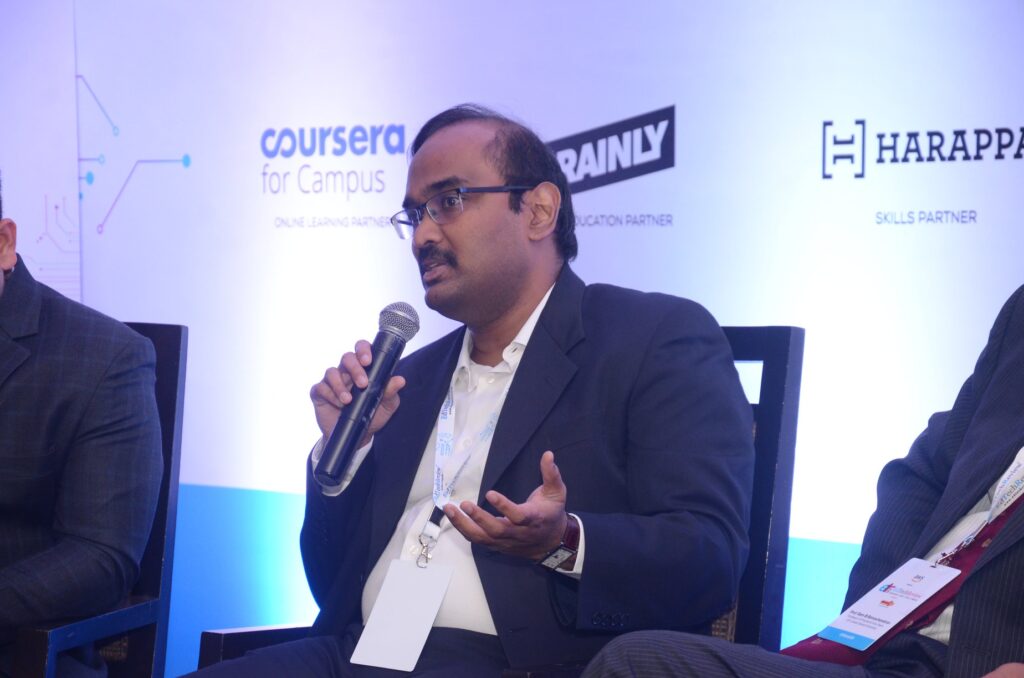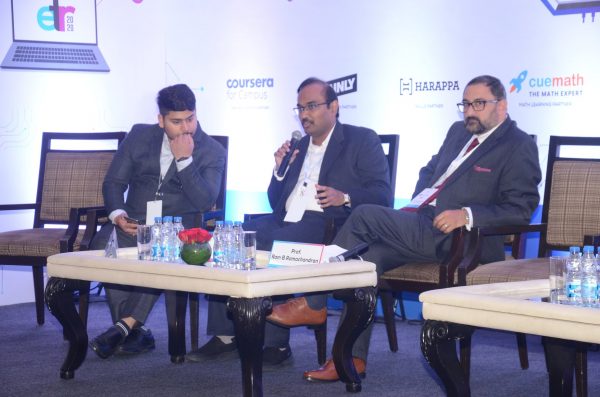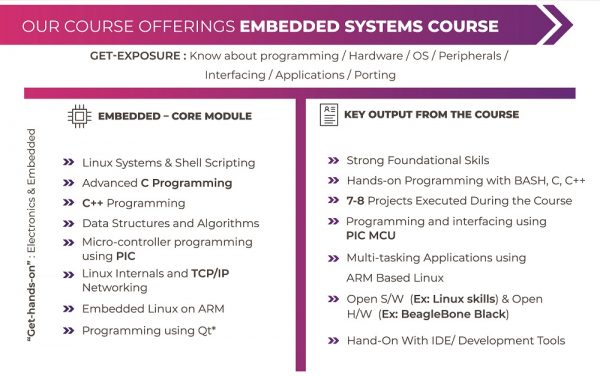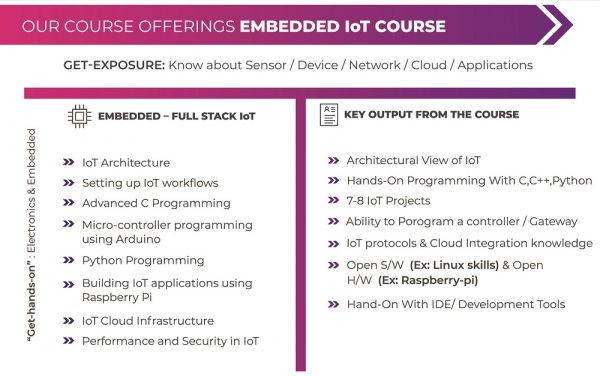Introduction
Emertxe, India’s best NSDC approved online course provider in embedded systems and embedded IoT, contributed to the EdTech ecosystem by participating in a panel discussion at the EdTech Review 2020, India’s leading education technology event.
The multinational event held on 5th and 6th March 2020 at the Leela Ambience Gurugram witnessed the gathering of 1000+ EdTech industry stakeholders – from founders and educators to investors. The best minds from India and other countries came together to map the trends, progress and forecast of EdTech in the past, present and future. The two-day event was packed with presentations, discussions and exhibitions of the latest impact of technology on education.
Participation from Emertxe at Edtech Review Conference 2020
Emertxe contributed to a panel discussion at the EdTech Review Conference 2020 on 6th March in the Maple Room. Jayakumar Balasubramanian (Director at Emertxe) was part of the panel discussion, where ‘Industry readiness for Youth – Role of tech to support learner’s needs’ was discussed with the Professor Ram, Practice and Vice-Dean of O.P Jindal University.
The CEO & Editor of EdTechReview, Utkarsh Lokesh moderated the discussion. The discussion centered around the following four points – scale and engagement of technology, learner behavior challenges, hybrid learning models to balance the student-teacher dynamic as well as providing resources students can return to and the discussion finally covered Emertxe’s T model for upskilling students.

The 4 pivotal discussion points central to ‘Industry readiness for Youth – Role of tech to support learner’s needs’ are detailed below
1. Scale Vs Engagement
The increasing widespread scalability of EdTech has been possible with technologies such as cloud computing, mobile internet, democratization of tools and the successful development of MOOCs or online courses such as Emertxe’s embedded systems course or embedded IoT online course.
It enables numerous students to avail the benefits of education in their chosen field through the internet from accredited institutions at just a click of a few buttons. MOOCs and online courses offer numerous benefits to their students. It offers a single platform for students of all abilities to interact and contribute.
In addition, students are encouraged to mix and match modules of their choice and at their pace, which becomes more complicated to implement in a standard lecture room environment. However, despite its merits, online learning has low learner engagement of only 10%-30%, varying across online course platforms, according to Financial Times.
Learner engagement can be defined as the “degree of attention, curiosity, interest, optimism, and passion that students show”. Technology inhibits, to a certain degree, the ability for educators to form psychographic profiles of its students.
This could stunt the growth and development of interpersonal skills of students. In today’s highly integrated and globalised job market, interpersonal skills are vital to secure employment as firms require solid foundations of strong teamwork and cooperation. Even at the placements drives that have been taking place at Emertxe for embedded systems engineers or embedded IoT engineers, this has been a recurring trait.
2. Learner Behaviour Challenges
The primary learner behaviour challenge has been the reducing attention span of students. The main reason behind this has been the advent of mobile phones and social media, where information received and communicated through messages are bite-size. According to a study by Microsoft Canada, cited by Time magazine, we now have “a shorter attention span than a goldfish”. Hence, due to these factors that have reduced the average attention span from 12 minutes to 5 minutes, technology-aided learning is being hampered by distractions.
Another major learner behaviour challenge is lower self-motivation among students due to the lack of competition and peer-to-peer learning which does take not place in a self-learning environment. According to a study, two types of motivation can be found among students, intrinsic and extrinsic.
Intrinsic motivation is derived when students find pleasure in learning. Extrinsic motivation is fostered by external rewards such as grades, scholarships and securing placements. It has been seen that major demotivating factors like an incomprehensible course content and a lack of learning environment can contribute to the discomfort felt by a student to reflect on the course. These can be easily avoided in the virtual classroom provided the educators and instructors are informed and proactive in creating a cohesive learning environment and even going as far as understanding the psychological ways in which they can support learning of their students.
The primary challenge in tier-2 and tier-3 cities is the high percentage of unemployed youth. Only 12% of 220 million who enroll in school, pursue higher education. The secondary challenges are lack of mentoring, continuous engagement and the inability to demonstrate success stories. This can be explained by the limited reachability of technology in tier 2 and tier 3 cities where the majority uptake through mobile phones is for entertainment, eCommerce and social media connectivity.
Traditional classroom learning methods are embedded in tier 2 and tier 3 city students’ psyche. This needs to be replaced with personalised learning to encourage curiosity and exploration. Students will be empowered and encouraged to play their part to successfully bring about change.
Hence, technology radically needs to support learner’s needs by fostering close-knit professional digital communities or networks to accelerate mentoring and the reach of success stories. Continuous engagement can be fostered on online courses through frequent reminders, structured intervention sessions, doubt clearing, practical assessments etc.
Rather than making online as a ‘content push’ it should be made as a ‘motivational pull’ by increasing student engagement at scale. Thus, technology needs to be supported by appropriate human intervention, especially if tier-2 and tier-3 cities are to contribute talent not just nationwide, but globally by producing skilled lifelong learners.

Hybrid Learning Model
In light of the challenges discussed above, the transformation of EdTech into a more user friendly and an all-inclusive domain is inevitable and essential for overcoming the digital divide (trust, bandwidth and connectivity issues of new technology).
The best solution is to integrate all aspects of student learning mechanisms and habits. This results in the emergence of an online hybrid learning model. The online hybrid learning model or blended learning model is one that provides the best of both worlds – a live teacher for coaching, mentoring and intervening when learning challenges arise and recorded lessons which students can refer to at their desired pace.
In addition, timely assessment and providing constructive feedback is a critical feature, especially for developing the interpersonal skills mentioned earlier and employability based training.
Importance of T Model for Skilling
The term T model refers to a generalising specialist, meaning that you need to have a wide understanding of how systems work across the board and together, but specialise in one or two disciplines with niche skills. These niche skills make up the vertical component of the T.
For example, in embedded systems practice, passion and patience is required. This becomes challenging in real-time product development as solutions are not always immediately found and require depth of investigation.
The horizontal component is made up of soft skills or transferrable skills that can be adapted to any environment – getting architectural perspective, designing effective algorithms, problem solving, debugging, interdisciplinary knowledge, open-mindedness and being able to use ideas from fields becomes very important.
The vertical side, specific in-depth and hands-on approach towards programming, peripheral interfacing, multi-tasking using Operating Systems, porting etc..plays an important role in terms of employability.
A right combination is both horizontal & vertical skills are imparted as a part of Emertxe’s Advanced Embedded Systems course and Emertxe’s Embedded IoT course. This approach was discussed during the panel discussion by demonstrating some real-time success stories.


Conclusion
The findings of the talk can thus be summarised into the benefits of technology, its limitations and the need for a blended learning or hybrid model that combines the best of both worlds.
The booming EdTech industry needs to transform and scale up into tier 2 and tier 3 cities, bridging the digital divide, despite the difficulties such as the lack of a vernacular language, scepticism surrounding digital payments, and disrupted content streaming. Another limitation of the technology is to equip the youth with transferable skills, whilst simultaneously acquiring the technical skills required by the industry for employability.
As the EdTech industry in the future reaches its maturity, the increased sophistication of the youth who have used it and brought about its growth and development will then be able to transform it into a bigger and better platform, exponentially reaching it to the far and further rural corners of not just India, but the globe.